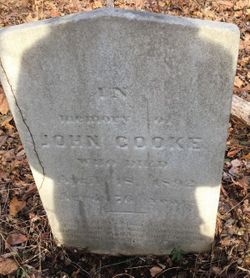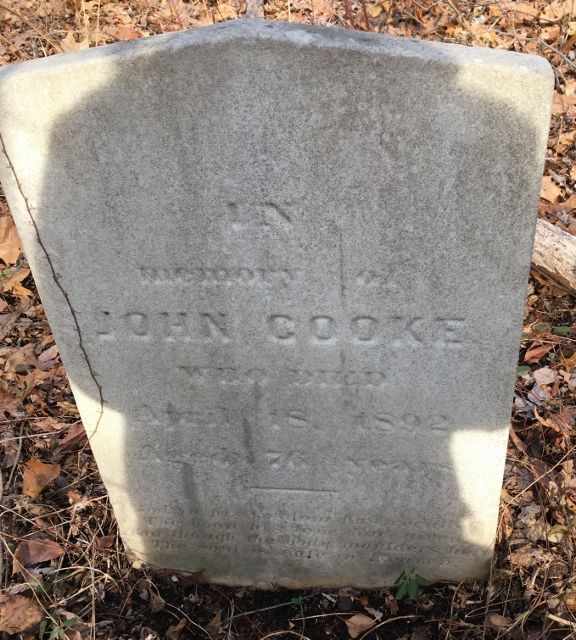Rev. John Cooke (aka “Cook”) was a London-born Baptist Minister who moved to Syosset shortly after the founding of the non-denominational Union Free Church (now the Syosset Community Church) in the early 1860’s. His home, also a working farm, was on the East Norwich Road (now Split Rock Road) as seen on the 1873 map below. In addition to serving the Baptist community and running his farm, Rev. Cooke, aided by his wife, Agnes, served as Syosset’s third Postmaster for twenty-five years beginning in December of 1867. Each day, he would take his horse-drawn wagon to the Syosset train station to check for incoming mail and leave outgoing mail in a burlap bag tied to a wooden pole beside the tracks. When residents wanted to collect or send mail, they would drop in to the “post office” set up in Rev. Cooke’s living room, where Mrs. Cooke might also serve them coffee.
Cooke, who claimed to have been the first minister to preach the Gospel in the state of California after the Gold Rush of 1849, had been affiliated with Baptist churches in New York City, Massachusetts, Oyster Bay, and Cold Spring Harbor before moving to Syosset. Based on announcements in local 19th Century newspapers, he appears to have been one of the most in-demand clergymen for weddings and funerals during the mid-1800’s.
Money wasn’t plentiful in Syosset in those days, but that didn’t keep Rev. Cooke from performing marriages for whatever payment couples could afford. Sometimes he would receive a bag of potatoes, corn, or other produce; other times, he would accept whatever trivial amount of coinage the couple could muster. Regardless of the circumstances, he would end every wedding ritual with “God bless you, my children. Go and live in peace.”
Perhaps one of the highlights of Cooke’s tenure in the ministry occurred in April of 1888, when two youngsters, Edward L. Bloomer (the son of a Syosset farmer) and Jane Cheshire (the daughter of Albert Cheshire, one of Syosset’s most prominent merchants and land owners) knocked on his door and asked to be married, right away. After some discussion and reassurances from the two twenty-somethings that their parents were in approval, Cooke hesitantly performed a brief ceremony and entered the couple’s names into the marital record. He bid the seemingly ecstatic newlyweds goodnight and went off to bed.
The very next morning, before dawn, Reverend Cooke was startled awake by the frantic banging of the new bride’s fists on his front door. He ran downstairs and opened the door to find Jane Bloomer shaking and teary-eyed, begging him to rescind the marriage immediately. When Rev. Cooke explained that he could not do so within the laws of his religion, the new bride became hysterical and eventually departed distraught and hopeless.
It must have weighed heavily on Reverend Cooke for the remaining years of his life that everyone in town gossiped about the miserable marriage of Edward and Jane Bloomer, knowing he had administered their wedding rites and had refused to nullify them. As he approached his 75th birthday, Rev. Cooke began to suffer paralysis and failing eyesight, and his duties as Syosset Postmaster began to suffer as a result. Hesitant to take the Postmaster position away from the aging minister, locals would instead sneak downtown to the train station early in the morning to handle their own mail, rather than wait for Rev. Cooke to bring it back home and sort it all out.
It may be a blessing that Rev. Cooke passed away in April of 1892, because shortly afterward, Edward Bloomer, who had earlier publicly threatened to murder his wife, was found dead with a large bullet wound in his chest. The coroner ruled the death a suicide, but locals who had witnessed an incoherent Jane Bloomer wandering through downtown Syosset at 4am that morning acting in a bizarre fashion, questioned the true circumstances of Mr. Bloomer’s death for the rest of Mrs. Bloomer’s life.
Agnes Cooke, the Reverend’s widow, to whom he had been married for fifty-two years, moved out of Syosset in 1903 to live with her nephew, James Scott, in St. Louis. She passed away there in 1911 at the age of 88. The Cooke property on Split Rock Road was purchased by Henry Warner, who over the next decade built Syosset’s first modern-day “neighborhood” on properties he obtained all along Split Rock Road. Today, these are some of the most exclusive home sites in town.
Rev. John Cooke (aka “Cook”) was a London-born Baptist Minister who moved to Syosset shortly after the founding of the non-denominational Union Free Church (now the Syosset Community Church) in the early 1860’s. His home, also a working farm, was on the East Norwich Road (now Split Rock Road) as seen on the 1873 map below. In addition to serving the Baptist community and running his farm, Rev. Cooke, aided by his wife, Agnes, served as Syosset’s third Postmaster for twenty-five years beginning in December of 1867. Each day, he would take his horse-drawn wagon to the Syosset train station to check for incoming mail and leave outgoing mail in a burlap bag tied to a wooden pole beside the tracks. When residents wanted to collect or send mail, they would drop in to the “post office” set up in Rev. Cooke’s living room, where Mrs. Cooke might also serve them coffee.
Cooke, who claimed to have been the first minister to preach the Gospel in the state of California after the Gold Rush of 1849, had been affiliated with Baptist churches in New York City, Massachusetts, Oyster Bay, and Cold Spring Harbor before moving to Syosset. Based on announcements in local 19th Century newspapers, he appears to have been one of the most in-demand clergymen for weddings and funerals during the mid-1800’s.
Money wasn’t plentiful in Syosset in those days, but that didn’t keep Rev. Cooke from performing marriages for whatever payment couples could afford. Sometimes he would receive a bag of potatoes, corn, or other produce; other times, he would accept whatever trivial amount of coinage the couple could muster. Regardless of the circumstances, he would end every wedding ritual with “God bless you, my children. Go and live in peace.”
Perhaps one of the highlights of Cooke’s tenure in the ministry occurred in April of 1888, when two youngsters, Edward L. Bloomer (the son of a Syosset farmer) and Jane Cheshire (the daughter of Albert Cheshire, one of Syosset’s most prominent merchants and land owners) knocked on his door and asked to be married, right away. After some discussion and reassurances from the two twenty-somethings that their parents were in approval, Cooke hesitantly performed a brief ceremony and entered the couple’s names into the marital record. He bid the seemingly ecstatic newlyweds goodnight and went off to bed.
The very next morning, before dawn, Reverend Cooke was startled awake by the frantic banging of the new bride’s fists on his front door. He ran downstairs and opened the door to find Jane Bloomer shaking and teary-eyed, begging him to rescind the marriage immediately. When Rev. Cooke explained that he could not do so within the laws of his religion, the new bride became hysterical and eventually departed distraught and hopeless.
It must have weighed heavily on Reverend Cooke for the remaining years of his life that everyone in town gossiped about the miserable marriage of Edward and Jane Bloomer, knowing he had administered their wedding rites and had refused to nullify them. As he approached his 75th birthday, Rev. Cooke began to suffer paralysis and failing eyesight, and his duties as Syosset Postmaster began to suffer as a result. Hesitant to take the Postmaster position away from the aging minister, locals would instead sneak downtown to the train station early in the morning to handle their own mail, rather than wait for Rev. Cooke to bring it back home and sort it all out.
It may be a blessing that Rev. Cooke passed away in April of 1892, because shortly afterward, Edward Bloomer, who had earlier publicly threatened to murder his wife, was found dead with a large bullet wound in his chest. The coroner ruled the death a suicide, but locals who had witnessed an incoherent Jane Bloomer wandering through downtown Syosset at 4am that morning acting in a bizarre fashion, questioned the true circumstances of Mr. Bloomer’s death for the rest of Mrs. Bloomer’s life.
Agnes Cooke, the Reverend’s widow, to whom he had been married for fifty-two years, moved out of Syosset in 1903 to live with her nephew, James Scott, in St. Louis. She passed away there in 1911 at the age of 88. The Cooke property on Split Rock Road was purchased by Henry Warner, who over the next decade built Syosset’s first modern-day “neighborhood” on properties he obtained all along Split Rock Road. Today, these are some of the most exclusive home sites in town.
Gravesite Details
Photo Courtesy of Mathew Meng
Family Members
Advertisement
Advertisement



